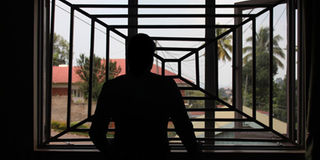The cost of living with HIV/Aids

Reflection. A woman living with HIV/Aids stands by the window in her house in Kampala. People living with HIV face many challenges, some which have seen them abandon medication. MONITOR PHOTO
What you need to know:
Prevalence rate. HIV/Aids prevalence stands at 8 per cent, with Kampala and south western Uganda having the highest rates at 7.9 per cent. Lango and Acholi sub-regions have 7.2 per cent prevalence; Bunyoro, Tooro and Rwenzori 5.7 per cent, Busoga and Bukedi at 4.7 per cent, while Bugisu and Sebei has a prevalence of 5.1 per cent. West Nile and Karamoja are at 3.1 and 3.7 per cent prevalence rates, respectively. Other Buganda districts such as Luweero and Nakasongola have an HIV/Aids prevalence of 7.6 per cent.
Hidden in her tender dimpled face is pain she has carried over the last 25 years. Her life has been one of pills. Ms Robinah Babirye has lost count of the number of tablets she has taken to keep her alive. The jolly, light-skinned HIV/Aids activist has soldiered on with the virus she acquired from her late parents amid challenges.
“At my age, when I walk in a health facility to get my medicine, health workers think I was reckless, had sex and that is how I contracted HIV,” Ms Babirye says.
“But even if that was the case, at this point in time, what one needs is care and support to adhere to treatment and not to be judged. This is not what we get. We are instead judged and discriminated against,” she adds.
People living with HIV face many challenges, some which have led to victims to abandon medication, Ms Babirye says.
“Some of our colleagues do not have a proper diet yet there are drugs you cannot take before you eat. Imagine those orphans under the guardianship of their grandparents who are poor and in rural areas!” she says.
People living with HIV/Aids, experts say, need a daily balanced diet to enable their bodies get the necessary nutrients. A balanced diet is one consisting of fruits, proteins, carbohydrates and vegetables.
Data by the Uganda Aids Commission (UAC) released last Wednesday shows that Uganda is registering 1,000 new HIV/Aids infections and 500 deaths from the viral disease per week, translating into 53,000 new infections and 23,000 deaths annually.
Most affected
Sadly, majority of the new infections are among youth aged 15 to 24, a trend health providers and policy makers say is unacceptable owing to available information and treatment for HIV/Aids.
An estimated 900 HIV/Aids cases were reported by 1986 in Uganda and in a space of two years, more other 6,000 people were diagnosed with the viral disease. The fight against further spread and treatment of HIV/Aids victims started and continues today with mixed success.
Ministry of Health data shows that by 1992, Uganda had a national HIV/Aids prevalence of 18 per cent but that dropped to 6.1 per cent in 2001 after massive education of the public about the disease.
As of 2018, UAC data shows, 1,400,000 people were living with the incurable disease. Of the 1,400,000 HIV/Aids people, government has enrolled 1,167,107 on treatment.
Mr Steven Watiti is one of the 1,400,000 people who are on treatment. He is happy that because of free ARVs distributed to them by government and partners, “you have helped us live”.
“The sporadic stock outs of ARVs have decreased and the number of people on ARVs has increased. We appreciate that people are cared for. We appreciate that government has combated TB, which contributes to 35 per cent deaths [in people living with HIV],” Mr Watiti says.
Dr Nelson Musooba, the director general of UAC, the national organisation, which oversees the strategy to combat HIV/Aids in the country, says enrolling such a big number of people on treatment has helped to suppress the virus and thus reducing the chances of people of spreading the disease.
But it has also drained resources that otherwise would be used for other development needs.
“The cost of maintaining a patient on ART [treatment] a year is averagely Shs1m. If you are adding patients every year, our economy will be just be drained,” Dr Musooba says, arguing that the best alternative is for people to avoid getting infected.
With 1.4 million people on treatment, it means Uganda spends Shs1.4 trillion annually in treating its citizens.
In a previous interview with this newspaper, Dr Musooba also stated that Uganda is on the right track to achieving the 90-90-90 UNAIDS goals, that is to have 90 per cent people in the country know their status, the same percentage of people started on treatment and another 90 per cent having their viral load suppressed by 2020.
With only five months to the deadline, Dr Musooba assured that the country has currently achieved 89-89-90 of the goals respectively, stating that they hope to hit all the targets.
Dr Joshua Musinguzi, the head of the HIV/Aids programme at Ministry of Health, says the ministry will longer carry out massive HIV/Aids testing but rather concentrate on target groups. This, he says, is intended to reduce on the expenses in carrying out tests on people who are already HIV/Aids positive or those at low risk.
New strategy
“We are introducing index testing. We want to improve the yield through targeted groups where you try to enlist HIV positive [people] partner who are likely to be exposed or living [without their knowledge] with HIV,” Dr Musinguzi says.
“We want to focus on men. Whereas identification and treatment for women we have reached about at 95 per cent, for men it is 75 per cent. All men, who come to our OPD [outpatient] or outreach programmes, will be tested,” he adds, clarifying that the exercise is voluntary.
Dr Chris Baryomunsi, the State minister for Housing, admits that fight against HIV/Aids has stagnated and more effort aimed at combating it needs to be upped.
“HIV remains the most pressing challenge the country faces. It is not yet time to celebrate although we have made progress,” Dr Baryomunsi says.
“In 1980s, treatment was not available, stigma was high and we did not have much information about HIV/Aids but we managed to reduce prevalence from 18.5 per cent [national prevalence] and up to 30 per cent prevalence in expectant mothers… but we can now say HIV fight has stagnated,” he adds.
On Ms Babirye’s part, the HIV/Aids fight is being derailed partly because of stigma which results in people not seeking medical attention and sometimes desperation among those people living with the disease.
“You want to start a long time relationship but our choices are limited. You find HIV-positive girls clinging on people or getting pregnant just because that person who has come is their only hope. Some decide to hide their status or stop medication completely to be in a relationship,” she says.
Attitude problem
The Uganda Demographic Health Survey, 2016, revealed that 33.4 per cent of women and 29 per cent of men had negative attitudes towards people living with HIV/Aids. The second national index study, which is still in draft form, shows that 6.7 per cent of people living with HIV/Aids were denied employment because of their status.
“A total of 6.7 per cent were denied employment leading to loss of income; 6 per cent chose not to apply for jobs while 4.8 per cent were denied residence in another country based on their HIV status,” the 12th annual Joint Aids Review report reads in part.
Ms Babirye remains hopeful amid the challenges of living positively and says “one day, there will come a cure of HIV”.
But as that cure is on its way, “my appeal to fellow youth is to know that HIV is real. Young people tend to take life for granted as though they buy it like bread in shop. HIV is real. Do not be reckless; protect those around you and if you are positive, adhere to treatment. It is your life you have to protect”.




